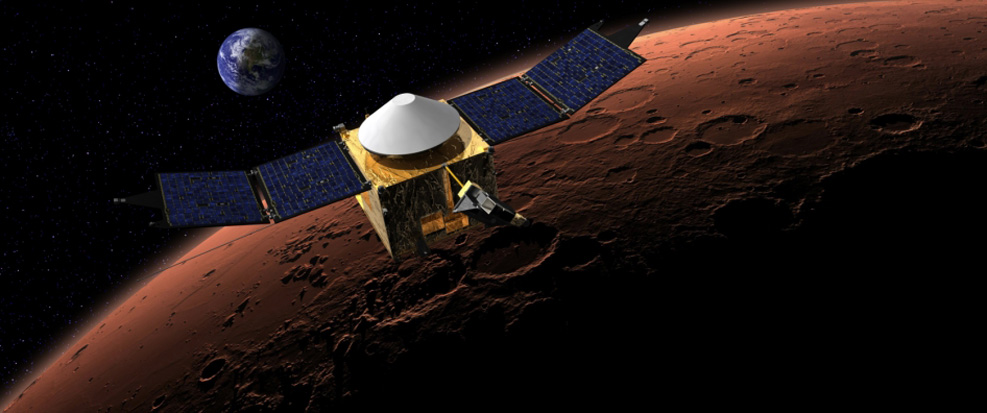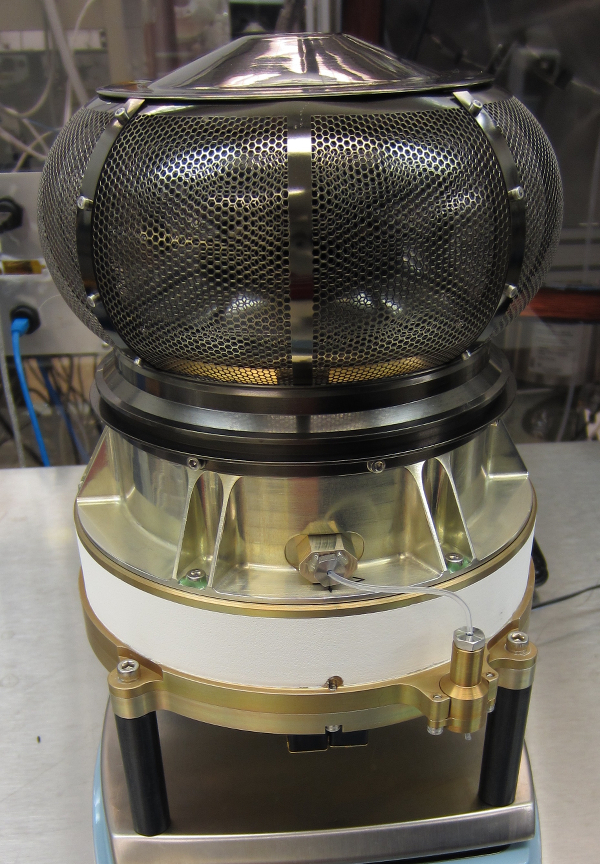How NASA's MAVEN Probe Will Investigate Mars Atmosphere Mystery

It's almost five times easier to leave Mars than it is to leave Earth or Venus.
At least, that's the case for many particles in the upper atmosphere. Mars' upper atmosphere is swarming with atoms, ions and molecules actively exiting the planet's sphere of influence. That's why NASA's Mars Atmosphere and Volatile EvolutioN spacecraft, or MAVEN, is headed there: to discover why.
"The basic goal of MAVEN is to understand what happened to the atmosphere of Mars," said Davin Larson, scientific lead for one of the MAVEN instruments, "It's not understood where the oceans and the atmosphere went to. It could have been absorbed into the regolith — sank down into the dirt — but it's pretty well accepted that Mars itself couldn't hide the entire atmosphere, and that most of it escaped." [NASA's MAVEN Mars Mission in Photos]
An atmosphere cannot engineer its own exit. Once an atom, ion or molecule has been captured from space or created in situ, securing release from the planet's sphere of influence typically requires an accomplice. The usual suspect in these cases is the sun.
One mechanism of freeing a captive particle is called Jeans escape. Jeans escape has nothing to do with clothing. It has everything to do with a molecule moving just fast enough to drift away. Jeans escape happens when a planetary atmosphere is heated, often by solar events. Particles that were previously content to hang around begin moving so fast that they attain escape velocity.
Another scenario of loss is photoionization. In this case, fast-moving photons from the sun knock electrons off atmospheric particles. The affected particles then carry a positive charge. Once particles carry a charge, they are more likely to get caught in magnetic fields or picked up by the solar wind and blown away.
In the meantime, the newly liberated electrons bounce around and break up other molecules. This process is known as dissociation. Dissociation can result from native Martian electrons bouncing around or directly from the solar wind. Every day, the solar wind's ions and radiation belts knock the atmosphere away, particle by particle, in a process called sputtering.
Breaking space news, the latest updates on rocket launches, skywatching events and more!
Sputtering, dissociation, photoionization, and Jeans escape: any of these mechanisms can cause loss in the ionosphere, or upper atmosphere. This in turns leads to the slow bleeding away of the lower atmosphere. In the absence of a protective magnetic field, these escape phenomena lead to atmospheric loss on a grand scale. Scientists think that Mars lost its planet-wide magnetic field about 3.8 billion years ago, and that the subsequent disappearance of its air and oceans have been largely driven by the sun.
Measuring the loss
To examine that hypothesis, MAVEN — which launched in November and is due to arrive at Mars this September — has been equipped with four sensors that measure every aspect of the solar input. Three of them have the word 'solar' in the title: the Solar Wind Electron Analyzer (SWEA), the Solar Energetic Particles (SEP), and the Solar Wind Ion Analyzer (SWIA). Larson, mentioned above, is the science lead on SEP, an instrument named after what it detects.
Solar energetic particles (SEPs), according to Larson, "are one form of energy that can ionize and heat the gas in the upper atmosphere of Mars." SEPs can arrive as part of large and small events. Small events would be SEPs blown by a light solar wind. Large events launch SEPs directly from the surface of the sun. Small SEP events might only sputter away molecules in the upper ionosphere, close to the boundary with space. During bigger events, SEPs can act like powerful cosmic rays and plow through everything in their path.
"The more energetic the particle, the deeper it tends to get into the atmosphere," Larson said. "There is more ionization, more excitation, more sputtering, more heating of the atmosphere."
Heating of the atmosphere gives rise to Jeans escape, which will be observed by other MAVEN instruments. Meanwhile, the SEP instrument sits on either side of the probe's central disk. Poised at the lower margin, the SEP sensors watch patiently for the interplanetary particles that create dissociation, ionization and sputtering.
Eye of an insect
On the other side of MAVEN's golden body, protruding 5 feet (1.5 meters) into space, is another Solar Package instrument: SWEA. With its glistening black patina and thatched circular grating, SWEA resembles the eye of a large insect.
"There are actually two concentric bug-eye grids," said David Mitchell, SWEA's science lead. "The instrument places a voltage across the inner and outer grids to decelerate incoming electrons without altering their trajectories."
Once electrons enter the eye, an internal electric field slows them down so SWEA can observe them. SWEA establishes which way the electrons were going and how quickly, and determines if those electrons originated in the sun or are native to Mars. In this way, it can read the solar wind's speed and direction of the ionosphere, where particles from the sun and Mars continually interplay, and contributing to sputtering the atmosphere away.
The solar wind itself is the object of yet another instrument's examination. With its sensor always turned toward the sun, the Solar Wind Ion Analyzer will measure the speed, contents, temperature and density of the solar wind.
"SWIA is built and designed to measure the incoming solar wind ions, both upstream and after the encounter the magnetosphere of Mars," said SWIA principal investigator Jasper Halekas. "These ions provide an important energy input to the magnetosphere of Mars, and may help determine how much of Mars' atmosphere ultimately escapes." [NASA's MAVEN Mars Probe: 10 Surprising Facts]
Around the atmosphere of any planet, electrons liberated by photoionization can form a free-flowing cloud called a plasmasphere. Mars' plasmasphere rotates independently from the planet, almost wrapping around it at times. Blobs of plasma trail behind Mars like two tails, blown there by the steady solar wind. The tails trail farther and farther behind Mars and are eventually lost to space.
While the solar wind's ions and electrons tend to remain in high altitudes near the plasmasphere, photons in the extreme ultraviolent part of the spectrum can ionize atmospheric particles all the way down to the ground. Extreme UV (EUV) radiation may be why Mars has too many heavy isotopes of elements like hydrogen and carbon, and too little air and water. In breaking apart chemical bonds, EUV may have played a part in helping the lighter bit of H2O and CO2 break away and escape.
"Knowing the amount of EUV going into an atmosphere and how that EUV varies lets scientists understand the temperature, ionization, composition, and escape rates from that atmosphere," said Frank Eparvier, EUV instrument lead.
By measuring the extreme UV in Mars' atmosphere today, and adding in data about the number of ionized molecules and their rates of escape, we may deduce how much H2O and CO2 existed on Mars four billion years ago. [7 Biggest Mysteries of Mars]
Like SEP, the EUV sensors were named after what they detect. The EUV sensors sit anchored at the bottom of two 23-foot (7 m) booms. Their presence there rounds out observations of incoming solar particles in the upper atmosphere. SWIA watches the solar wind. SWEA sorts solar electrons, counting how many charges stick in Mars' atmosphere, and how deep into they penetrate. SEP detects ionizing particles and EUV senses ionizing radiation all through the upper atmosphere, brought to Mars largely by coronal mass ejections (CMEs).
CMEs, SEPs and the solar wind have each played a part in divesting Mars of its atmosphere over the last four billion years. With its Sun, Solar Wind and Storms instruments, MAVEN will tell us how much of each is occurring and where.
Coupled with measurements from the five other instruments on board, by this time next year we'll have a more complete picture of what's entering in and leaving the ionosphere. We'll have a better idea of what happened to 85-95 percent of Mars' original atmosphere, which likely supported rivers, lakes and shallow oceans. Above all, for the first time ever, we'll know much energy it takes to strip away the sky.
This story was provided by Astrobiology Magazine, a web-based publication sponsored by the NASA astrobiology program.
Follow us @Spacedotcom, Facebook or Google+. Article published on Space.com.




